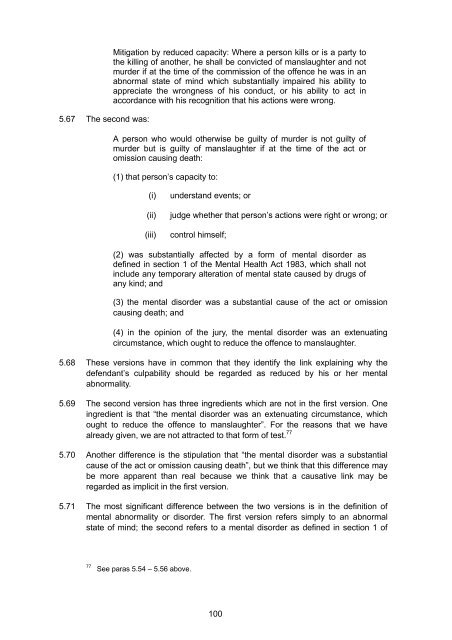lc290 Partial Defences to Murder report - Law Commission
lc290 Partial Defences to Murder report - Law Commission
lc290 Partial Defences to Murder report - Law Commission
You also want an ePaper? Increase the reach of your titles
YUMPU automatically turns print PDFs into web optimized ePapers that Google loves.
5.67 The second was:<br />
Mitigation by reduced capacity: Where a person kills or is a party <strong>to</strong><br />
the killing of another, he shall be convicted of manslaughter and not<br />
murder if at the time of the commission of the offence he was in an<br />
abnormal state of mind which substantially impaired his ability <strong>to</strong><br />
appreciate the wrongness of his conduct, or his ability <strong>to</strong> act in<br />
accordance with his recognition that his actions were wrong.<br />
A person who would otherwise be guilty of murder is not guilty of<br />
murder but is guilty of manslaughter if at the time of the act or<br />
omission causing death:<br />
(1) that person’s capacity <strong>to</strong>:<br />
(i) understand events; or<br />
(ii) judge whether that person’s actions were right or wrong; or<br />
(iii) control himself;<br />
(2) was substantially affected by a form of mental disorder as<br />
defined in section 1 of the Mental Health Act 1983, which shall not<br />
include any temporary alteration of mental state caused by drugs of<br />
any kind; and<br />
(3) the mental disorder was a substantial cause of the act or omission<br />
causing death; and<br />
(4) in the opinion of the jury, the mental disorder was an extenuating<br />
circumstance, which ought <strong>to</strong> reduce the offence <strong>to</strong> manslaughter.<br />
5.68 These versions have in common that they identify the link explaining why the<br />
defendant’s culpability should be regarded as reduced by his or her mental<br />
abnormality.<br />
5.69 The second version has three ingredients which are not in the first version. One<br />
ingredient is that “the mental disorder was an extenuating circumstance, which<br />
ought <strong>to</strong> reduce the offence <strong>to</strong> manslaughter”. For the reasons that we have<br />
already given, we are not attracted <strong>to</strong> that form of test. 77<br />
5.70 Another difference is the stipulation that “the mental disorder was a substantial<br />
cause of the act or omission causing death”, but we think that this difference may<br />
be more apparent than real because we think that a causative link may be<br />
regarded as implicit in the first version.<br />
5.71 The most significant difference between the two versions is in the definition of<br />
mental abnormality or disorder. The first version refers simply <strong>to</strong> an abnormal<br />
state of mind; the second refers <strong>to</strong> a mental disorder as defined in section 1 of<br />
77 See paras 5.54 – 5.56 above.<br />
100

















